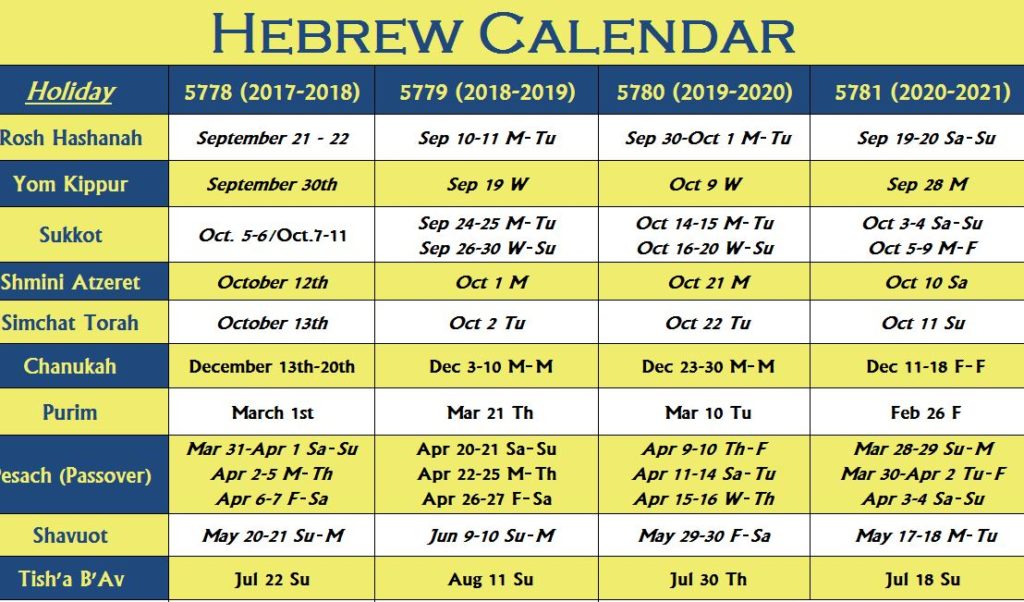Understanding The Hebrew Calendar - Features a brief summary of key events in jewish history, laws and customs, shabbat times and more. It is based on the moon’s rotation around the earth and the earth’s rotation around the sun and it lopsided axis. Web the jewish calendar is a lunar calendar with a solar adjustment. Web an understanding of the hebrew calendar is important to us as christians because it increases our understanding of the bible and biblical events. In ancient times, the new months used to be determined by observation. The high holidays, sukkot, chanukah, purim, passover and shavuot are always celebrated on their specific dates on the jewish calendar.
A year in the hebrew calendar can be 353, 354, 355, 383, 384, or 385 days long. When a thin crescent of. Nature and history, universal and particular. Web a standard jewish year has twelve months; Web the hebrew calendar, also known as the jewish calendar, is a unique system that has been used by jewish communities for thousands of years, putting most of 2023 as the year 5783.
Web a closer look at the mathematics behind the jewish calendar, explaining how hebrew dates are calculated. The hebrew calendar has been used for thousands of years and has undergone many changes and adaptations throughout history. Leap years have 13 months and are 384 days long. Web the current jewish calendar, displaying the current three months with holidays and weekly torah portions. Web a standard jewish year has twelve months;
Web since biblical times, various astronomical phenomena have been used to establish uniquely jewish definitions for the day and its hours, the months and the year. Sun, moon, and holy scripture. In distinction to the day added to the secular leap year, the jewish calendar adds a full month to the end of its year. Web the jewish calendar is a lunar calendar with a solar adjustment.
Judaism Marks And Celebrates Time In A Number Of Ways — Holidays, Shabbat, The Weekly Readings Of Specific Portions Of The Torah, And The Rituals Of The Personal Life Cycle.
In distinction to the day added to the secular leap year, the jewish calendar adds a full month to the end of its year. A year in the hebrew calendar can be 353, 354, 355, 383, 384, or 385 days long. Web a standard jewish year has twelve months; Web if you’re unfamiliar with the hebrew calendar, then you’ve come to the right spot.
Free Annual Email Reminders & Calendar Downloads.
Hallûaḥ hāʿiḇrî), also called the jewish calendar, is a lunisolar calendar used today for jewish religious observance and as an official calendar of israel. Web the hebrew calendar (hebrew: The high holidays, sukkot, chanukah, purim, passover and shavuot are always celebrated on their specific dates on the jewish calendar. Web the essence of the hebrew calendar.
In Ancient Times, The New Months Used To Be Determined By Observation.
The names of the months reflect their babylonian origins and are still in use today. Take the temple, for example. The pillars of the calendar are the high holidays, the building blocks are the days, marked by daily commandments upon every jewish man and woman to comply with, and the weeks, marked by the sabbath. Months in the jewish calendar.
Web The Jewish Calendar Is The Structure Upon Which All Jewish Holidays Are Based.
Regular common years have 12 months with a total of 354 days. It is a lunisolar calendar, which means it is based on both the lunar cycle and the solar year. Web the most comprehensive and advanced jewish calendar online. Provides sample javascript code to show how the calculations work.
Some holidays are set when the moon is at its brightest to allow for additional light for evening gatherings, which was particularly useful in ancient times. Features a brief summary of key events in jewish history, laws and customs, shabbat times and more. Learn about the jewish calendar, its background and history, the numbering of jewish years, the months of the jewish year and the days of the jewish week. Due to variations in the jewish calendar, 1 however, the year could also be 353 or 355 days. Web a closer look at the mathematics behind the jewish calendar, explaining how hebrew dates are calculated.





